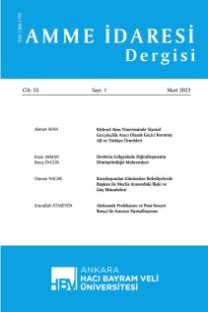Türk Ulusçuluğunun Kültürel Araçları
Türk ulusçuluğunun doğuş ve yükseliş evresinde ulusal kimliğin özünü bulma amacıyla başlatılan "halka doğru" akımı sırasında gidilen kaynak 'köy'dür. Bunda en temel amaç, Türk ulusunun özelliklerini en katışıksız toplum birimi olan köyden derlemek ve bir ulus yaratmaktır. Bu yöneliş, Cumhuriyet döneminde de devam etmiş, bir ulus yaratma projesinin temeli olmuştur. Bu amaçla aydınlar köye yönelmiş, halk ağzından derleme çalışmaları yapılmış, köy sanatının modern bir edebiyattan resim sanatına, müzikten halk oyunlarına geniş bir alanda modern sanata malzeme oluşturması amaçlanmıştır. Ne var ki resmi kültür odaklarınca desteklenen kimi sanatçılar folklorcu bir söyleyişi çoğaltırken kimi toplumcu sanatçılar halk kültürünü aynen çoğaltmak yerine, eleştirel bir süzgeçten geçirip yeni ve ulusal bir sanat yaratmayı seçmişlerdir
Cultural Elements of Turkish Nationalism
The emergence of folklore is closely related to the birth of Turkish nationalism because during the birth and the rising stage of Turkish nationalism, a movement called 'towards public' was initiated to find the core of national identity and during this movement, the source, which was referred to, was the 'village'. The major reason for this is to glean the features of Turkish people from the village, the purest social unit and thus to create a nation. This trend continued to prevail during the Republic period and became the foundation of the project for creating a nation. Therefore, intellectuals turned their face towards the village and began to compile all kinds of cultural elements from people's mouth to make the village a center that provides inspiration and material from music to folk dances to art. Nevertheless, this romantic village movement that was once supported by state cultural organizations and continued with some artists produced works using a folkloric discourse, some socialist poets, instead of augmenting the public culture, preferred creating a new and national art through filtering the public culture through a critical standpoint
___
- Akçura, Y. (1976), Üç Tarz-ı Siyaset, Türk Tarih Kurumu Yayınları, Ankara.
- Akçura, Y. (2001), Türkçülüğün Tarihi, Kaynak Yayınları, İstanbul.
- Akçuraoğlu, Y. (1329) Akçuraoğlu Yusuf, "Halka 5", Halka Doğru, Yıl:I, Sayı: 31 (7 Teşrinisani 1329) aktaran: F. S. Şirin, "Türk Aydınının Anadolu'ya yönelişinde Balkan Savaşlarının Rolü", Tarih İncelemeleri Dergisi XXVIII / 2, 2013, 523- 548.
- Akı, N. (1960), Yakup Kadri Karaosmanoğlu, İstanbul.
- Alkan, T. (1979) , Siyasal Toplumsallaşma, T.C. Kültür Bakanlığı Yayınları, Ankara.
- Aydemir, Ş.S. (1965), Suyu Arıyan Adam, Remzi Kitabevi, İstanbul: 63'den aktaran, İlhan Tekeli - Selim İlkin, Kadro'cuları ve Kadro'yu Anlamak. Bir Cumhuriyet Öyküsü, Türkiye Ekonomik ve Toplumsal Tarih Vakfı Yayınları, İstanbul, 2003.
- Başgöz, İ. (2011) , "Türkiye'de Folklor Çalışmaları ve Milliyetçilik", (Çev. Serdar Uğurlu), Turkish Studies- International Periodical For The Languages, Literature and History of Turkish or Turkic Volume 6/3 Summer 2011, p.1535-1547
- Bezirci, A. (1995), Orhan Veli. İstanbul: Evrensel Basım Yayım.
- Birol, E. (2009) Son Dönem Osmanlı Aydını Mizancı Murad Bey, Kitabevi Yayınları, İstanbul.
- Boratav, P. N. (1982), Folklor ve Edebiyat 1 -1982, Adam Yayıncılık, İstanbul.
- Eyüboğlu, S. (1967), Mavi ve Kara (Denemeler) (1940 - 1966), Çan Yayınları, İstanbul.
- Gökalp, Z. (1955), Türkçülüğün Esasları, Varlık Yayınları, İstanbul.
- Kirby, F. (1962), Türkiye'de Köy Enstitüleri, İmece Yayınları, İstanbul.
- Levent, A. S. (1949), Türk Dilinde Gelişme ve Sadeleşme Safhaları(Ankara, 1949), aktaran, Başgöz, İlhan (2011), "Türkiye'de Folklor Çalışmaları ve Milliyetçilik", (Çev. Serdar Uğurlu), TurkishStudies- International PeriodicalForTheLanguages, LiteratureandHistory of TurkishorTurkic Volume 6/3 Summer 2011, p.1535-1547).
- Gedikoğlu, Ş. (1971) , Evreleri, Getirdikleri ve Yankılarıyla Köy Enstitüleri, Ankara,.
- Karpat, K. H. (1996), Türk Demokrasi Tarihi - Sosyal, Ekonomik, Kültürel Temeller, Afa Yayınları, İstanbul
- Hikmet, N. (1969), Kemal Tahir'e Hapishaneden Mektuplar, Bilgi Yayınevi, Ankara.
- Oktay, A. (1986), Toplumcu Gerçekçiliğin Kaynakları, BFS Yayınları, İstanbul.
- Ortaylı, İ. (2005), İmparatorluğun En Uzun Yüzyılı, İstanbul, Alkım Yayınları, İstanbul.
- Öztürkmen, A. (1998), Türkiye'de Folklor ve Milliyetçilik, İletişim Yayınları, İstanbul.
- Rıfkı, F. (1980), "Bizim Köy", Kadro Dergisi, Cilt 2, Sayı 18, 1933, tıpkıbasım, Gazi Üniversitesi, İİBF Yayını, Ankara.
- Sertel, Z. (1969), Mavi Gözlü Dev, Ant Yayıncılık, İstanbul.
- Süreya, C. (1992), Folklor Şiire Düşman, Can Yayınları, İstanbul.
- Süreyya, Ş. (1980) "Sosyal Milliyetçiliğin Zaferi", Kadro Dergisi, Cilt:3, Sayı:35-36, tıpkıbasım, Gazi Üniversitesi, İİBF Yayını, Ankara.
- Tanpınar, A. H. (2011), Edebiyat Üzerine Makaleler, (Haz.) Zeynep Kermanlı, Dergah Yayınları, İstanbul.
- Tecer, L. (2001), Ahmet Kutsi Tecer'in Bütün Şiirleri, Ankara: Kültür Bakanlığı Yayınları.
- Tekeli, İ. ve İlkin, S. (2003), Kadro'cuları ve Kadro'yu Anlamak. Bir Cumhuriyet Öyküsü, Türkiye Ekonomik ve Toplumsal Tarih Vakfı Yayınları, İstanbul.
- Tonguç, E. (1970), Devrim Açısından Köy Enstitüleri ve Tonguç, Ant Yayınları, İstanbul
- Timur, T. (1986), Osmanlı Kimliği, Hil Yayın, İstanbul.
- Timur, T. (1971), Türk Devrimi ve Sonrası (1919-1946), Doğan Yayınevi, Ankara.
- Tunçay, M. (1981), T.C.'inde Tek Parti Yönetiminin Kurulması (1923-1931), Yurt Yayınları, Ankara.
- Tunaya, T. Z. (2001) , Türkiye'de Siyasal Partiler, Cilt 3, İletişim Yayınları
- Tütengil, C. O. (1969), Türkiye'de Köy Sorunu, Kitaş Yayınları, İstanbul.
- Uluskan, S. B. (2010), Atatürk'ün Sosyal ve KültürelPolitikaları, Atatürk Kültür, Dil veTarihYüksek Kurumu - Atatürk Araştırma Merkezi Yayınları, Ankara.
- Ülken, H. Z. (1997), Uyanış Devirlerinde Tercümenin Rolü, Ülken Yayınları, İstanbul.
- Üstel, F. (1997), İmparatorluktan Ulus - Devlete Türk Milliyetçiliği: Türk Ocakları, 1922-1931, İletişim Yayınları, İstanbul.
- ISSN: 1300-1795
- Yayın Aralığı: Yılda 4 Sayı
- Başlangıç: 1968
- Yayıncı: -
